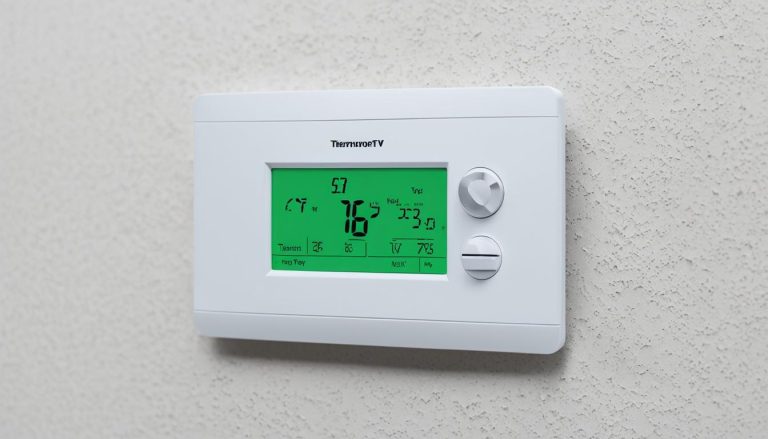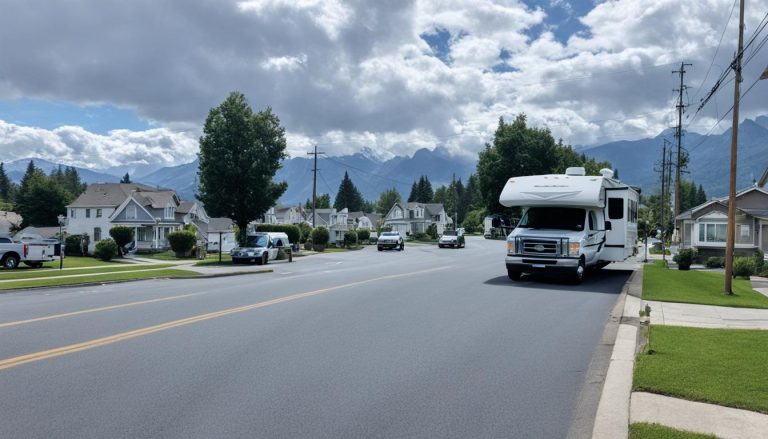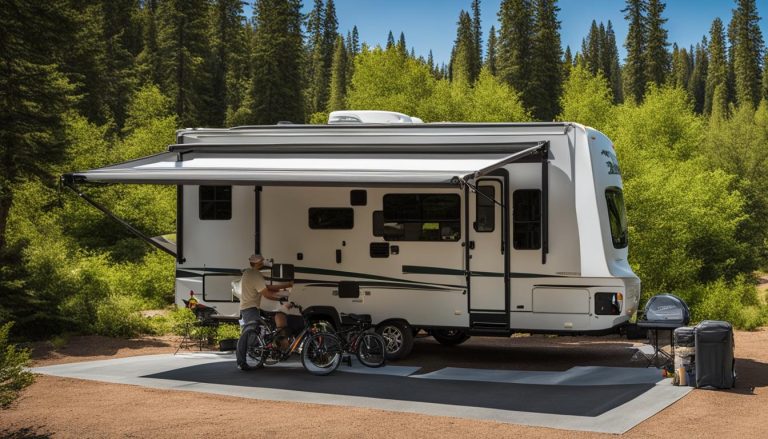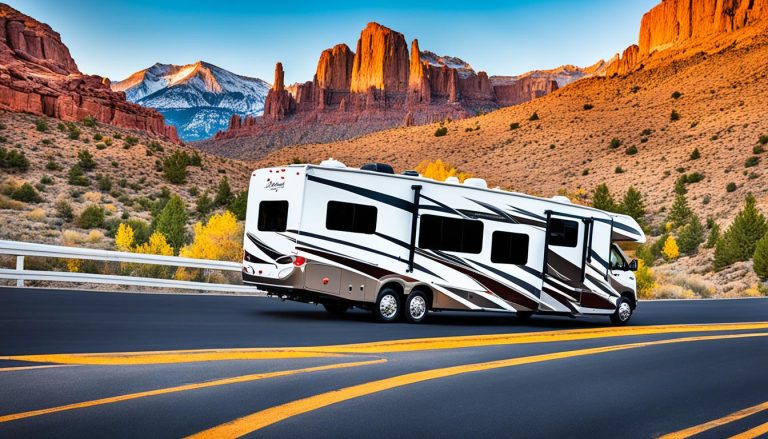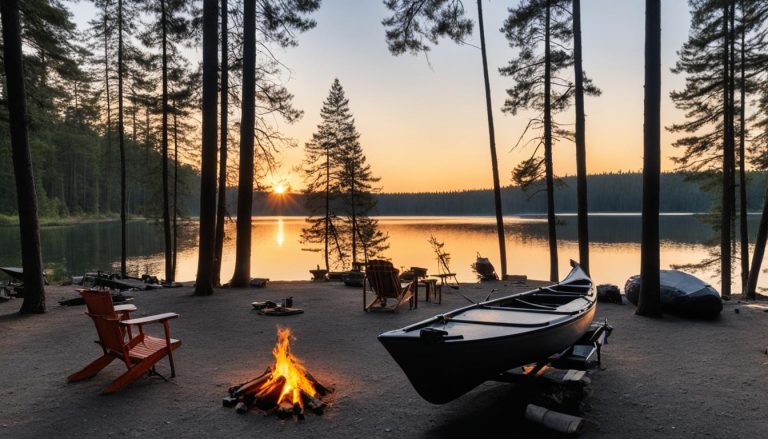Sanitize Your RV Fresh Water Tank Effectively
gorvlifestyle.com and its partners may earn a commission if you purchase a product through one of our links
Sanitizing the fresh water tank in your RV is an essential maintenance task that ensures clean and safe water for drinking, showering, and washing dishes. Regular sanitization helps eliminate bacteria, mold, and mildew that can grow in the tank and water lines. In this article, we will discuss why it’s important to sanitize your RV fresh water tank, when to do it, and how to effectively sanitize the tank.
Key Takeaways:
- Sanitizing your RV fresh water tank is crucial for clean and safe water while traveling.
- Regular sanitization helps eliminate harmful bacteria, mold, and mildew.
- It is recommended to sanitize your tank every six months.
- All you need to sanitize your tank is regular bleach, a funnel, and clean water.
- Follow the step-by-step process to effectively sanitize your RV fresh water tank.
Why Sanitize Your RV Fresh Water Tank?
Sanitizing your RV fresh water tank is crucial for the health and safety of you and your family during your travels. The water used to fill the tank may not always be clean, and over time, bacteria, mold, and mildew can grow in the tank and water lines. By regularly sanitizing your RV water system, you can eliminate these harmful pathogens and ensure that you have clean and safe water wherever you go.
Sanitization is especially important if you plan on using your RV for drinking, showering, or cooking. Contaminated water can lead to illness and discomfort, which can ruin your trip. By taking the time to properly disinfect and sanitize your RV’s fresh water tank, you can have peace of mind knowing that you and your loved ones are protected.
“Regular sanitization helps eliminate bacteria, mold, and mildew that can grow in the tank and water lines.”
Image:
When to Sanitize RV Fresh Water Tank Systems
Regular maintenance and proper sanitation of your RV fresh water tank are essential for ensuring the cleanliness and safety of your water supply. While it is generally recommended to sanitize the tank every six months, there are certain situations where immediate sanitization is necessary.
If you notice any unusual taste or smell in the water, it could indicate the presence of bacteria or contaminants in your fresh water tank. In such cases, it’s crucial to sanitize the tank immediately to prevent any health risks.
If your RV has been in storage for an extended period, the stagnant water in the tank can become a breeding ground for bacteria and mold. It’s important to sanitize the tank before using it again to ensure that the water is clean and safe.
In addition, if you have any doubts about the quality of the water used to fill your fresh water tank, it’s always better to err on the side of caution and perform a sanitization process. Water from unfamiliar sources or questionable campground connections may contain impurities that can compromise your water supply.
By being proactive and aware of these signs, you can maintain the integrity of your fresh water system and ensure that you are always using clean and safe water during your RV travels.
| When to Sanitize RV Fresh Water Tank Systems | Why |
|---|---|
| If there is an unusual taste or smell in the water | Indicator of bacteria or contaminants present in the tank. |
| If the RV has been in storage for a long period | Prevents bacteria and mold growth in stagnant water. |
| If there are doubts about the water source | Ensures the safety and cleanliness of the water supply. |
What You Need to Sanitize Your RV Fresh Water Tank and System
Sanitizing your RV fresh water tank is a simple process that requires just a few supplies. Here’s what you’ll need:
- Regular bleach
- A funnel
- A clean water source
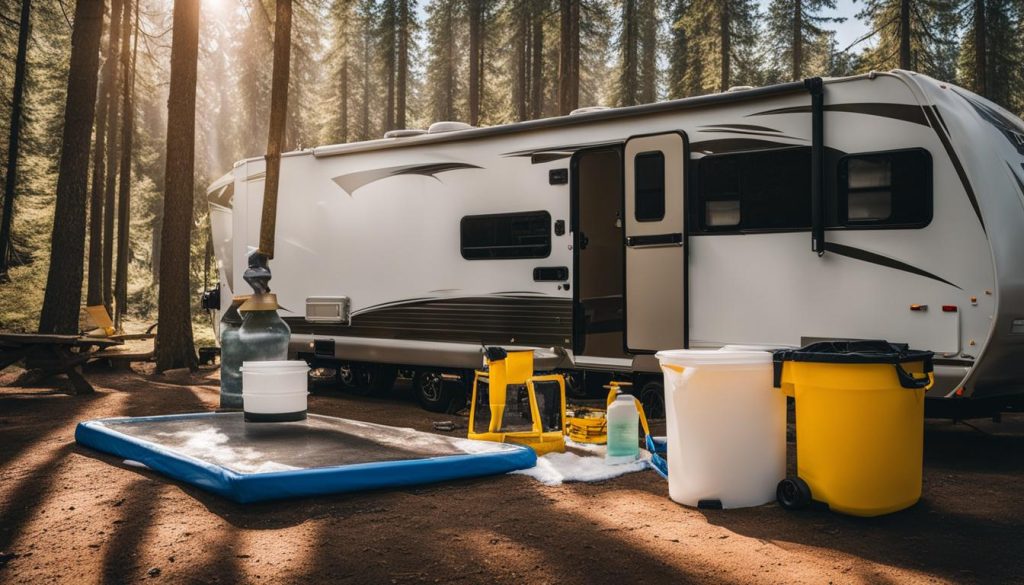
Bleach is an effective sanitizer and will help eliminate bacteria and other pathogens from your RV’s fresh water tank. The ratio of bleach to water will depend on the size of your tank. You can refer to the manufacturer’s instructions for specific guidance on the appropriate ratio.
Alternatively, there are also sanitizers available on the market that are specifically designed for RV fresh water systems. These sanitizers provide an easy and convenient option for maintaining the cleanliness of your RV’s water system.
Both bleach and RV water tank sanitizers are easily obtainable and affordable, making it a straightforward task to keep your RV’s water system in top condition. By having these supplies readily available, you can ensure that your RV’s fresh water tank is properly sanitized and ready for your next adventure.
How to Sanitize RV Fresh Water Tank
The process of sanitizing your RV fresh water tank involves several steps. Follow the instructions below to ensure that your water tank is properly cleaned and safe to use.
- Turn off the water heater and water pump to prevent any damage during the sanitization process.
- Bypass the water heater and filter to focus solely on the fresh water system.
- Drain the entire fresh water system, including the low-point drains, to remove any remaining water.
- Create a bleach mixture by following the manufacturer’s instructions and adding it to the tank. Be sure to maintain the correct ratio of bleach to water.
- Fill the tank with potable water, ensuring that it is of good quality.
- Turn on the pump and open all faucets to circulate the bleach mixture throughout the system.
- Let the bleach mixture sit in the tank for 24 hours to effectively sanitize the tank.
- After 24 hours, drain the tank completely and refill it with fresh, clean water.
- Run the faucets until the bleach smell is gone, indicating that the tank is now properly sanitized.
By following these step-by-step instructions, you can ensure that your RV fresh water tank is thoroughly cleaned and safe for use.
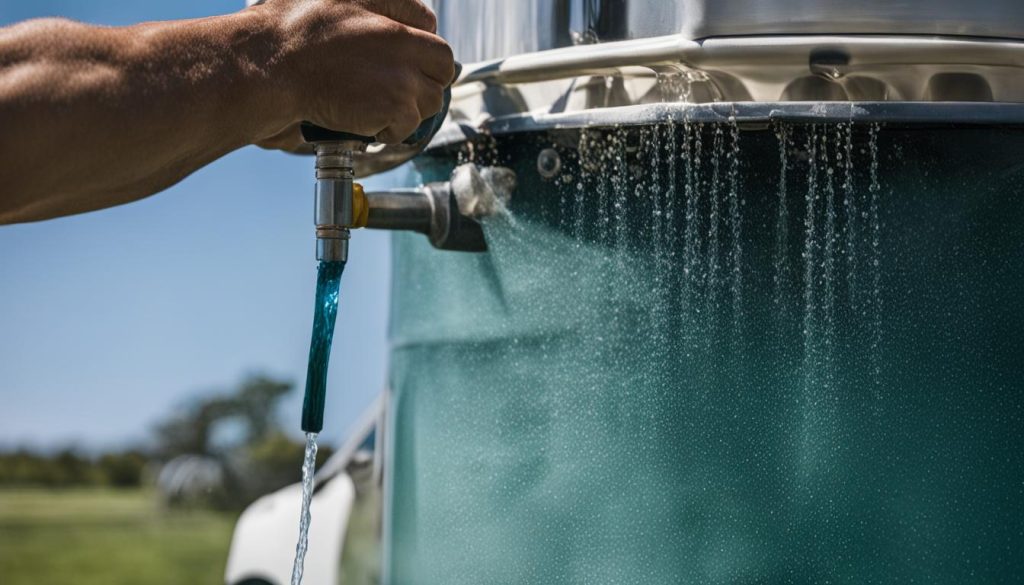
Why is Sanitizing Your RV Fresh Water Tank Important?
Regular sanitization is crucial to eliminate bacteria, mold, and mildew that can grow in the tank and water lines, ensuring that your family has clean and safe water while traveling in your RV.
Sanitizing your RV fresh water tank should be a regular part of your maintenance routine to keep your water system in optimal condition. By following these steps, you can enjoy worry-free travels knowing that your fresh water tank is properly sanitized and free from harmful contaminants.
Tips for Effective RV Fresh Water Tank Sanitization
When it comes to maintaining a clean and safe water supply in your RV, proper sanitization of the fresh water tank is crucial. To ensure maximum cleanliness and safety, here are a few tips to optimize the sanitization process:
- Start with an empty gray tank: Before sanitizing your fresh water tank, make sure your gray tank is empty. This helps ensure that the entire system is clean and fresh water can flow properly.
- Have sewer hookups for dumping: Having sewer hookups readily available allows you to properly dump any waste water from the sanitization process. This helps maintain hygiene and prevents any contamination.
- Follow manufacturer’s instructions: Different RV models and fresh water tanks may have specific guidelines for sanitization. It’s important to adhere to the manufacturer’s instructions, especially when it comes to mixing bleach and water ratios. This ensures that the sanitization process is effective and safe.
- Regularly check and tighten hose clamps: The filler tube of your fresh water tank is connected by a hose clamp. Regularly inspect and tighten the clamp to prevent leaks and ensure a secure connection. This helps maintain the integrity of your fresh water system.
By following these tips, you can achieve maximum cleanliness and safety when sanitizing your RV fresh water tank. Keep in mind that regular maintenance and proper sanitization are essential for maintaining a healthy water supply while on the road.
Testimonials:
“Following the tips provided in this article has made the sanitization of my RV fresh water tank a breeze. I feel confident in the cleanliness of my water supply while on the road.” – Sarah
| Benefit | Explanation |
|---|---|
| Optimal cleanliness | Following these tips ensures that your fresh water tank is properly sanitized, providing clean and safe water for your RV adventures. |
| Prevents contamination | Starting with an empty gray tank, having sewer hookups, and checking hose clamps help prevent contamination and maintain the integrity of your water system. |
| Easy maintenance | By following the manufacturer’s instructions and regularly checking hose clamps, you can easily maintain the cleanliness of your RV fresh water tank. |
Conclusion
Sanitizing your RV’s fresh water tank is essential for maintaining clean and safe water while you travel. By following the step-by-step process and adhering to the recommended timing, you can ensure that your RV’s water system remains in optimal condition. Regular maintenance and sanitization will allow you to enjoy your RV adventures without worrying about the quality of your water.
Keeping your fresh water tank clean is crucial for your health and well-being on the road. By prioritizing the cleanliness of your tank, you can have peace of mind knowing that you and your loved ones are drinking and using water that is free from harmful bacteria, mold, and mildew.
Make sure to follow the proper procedures outlined in this article to sanitize your RV’s fresh water tank effectively. Regular maintenance and conscientious sanitization practices will help you stay healthy and happy as you travel. So, don’t forget to prioritize the cleanliness of your fresh water tank and enjoy your RV adventures to the fullest!
FAQ
Why is it important to sanitize your RV fresh water tank?
Sanitizing your RV fresh water tank is crucial because the water used to fill the tank may not always be clean. Additionally, bacteria, mold, and mildew can grow in the tank and water lines over time. Sanitization helps eliminate these pathogens and ensures that your family has clean and safe water while traveling in your RV.
When should you sanitize your RV fresh water tank?
It is recommended to sanitize your RV fresh water tank every six months. However, if you notice any strange taste or smell in the water, if the RV has been in storage for a long time, or if you suspect that the water used to fill the tank was not clean, it’s important to sanitize the tank immediately. Regular maintenance and awareness of water quality are essential for keeping your fresh water system in optimal condition.
What do you need to sanitize your RV fresh water tank?
To sanitize your RV fresh water tank, you will need regular bleach, a funnel, and a clean water source. Bleach is an effective sanitizer, and its ratio to water depends on the size of your fresh water tank. Other sanitizers specifically designed for RV fresh water systems are also available on the market. These supplies are easily obtainable and affordable, making it simple to maintain the cleanliness of your RV’s water system.
How do you sanitize an RV fresh water tank?
The process of sanitizing your RV fresh water tank involves several steps. First, you need to turn off the water heater and water pump to prevent any damage. Then, bypass the water heater and filter to focus on the fresh water system. Next, drain the entire fresh water system, including the low-point drains. Create a bleach mixture and add it to the tank, ensuring the right ratio of bleach to water. Fill the tank with potable water, then turn on the pump and open all faucets to circulate the bleach mixture. Let it sit for 24 hours, then drain the tank and refill it with fresh water. Finally, run the faucets until the bleach smell is gone. This thorough process ensures that your RV fresh water tank is properly sanitized.
What are some tips for effective RV fresh water tank sanitization?
To optimize the sanitization process, it is recommended to start with an empty gray tank and have sewer hookups for dumping. This ensures that the entire system is clean and fresh water can flow properly. Additionally, following the manufacturer’s instructions for mixing bleach and water ratios is important to maintain the effectiveness of the sanitization process. Regularly checking and tightening the hose clamp on the freshwater tank’s filler tube helps prevent leaks and ensures a secure connection. Following these tips can help you achieve maximum cleanliness and safety when sanitizing your RV fresh water tank.

